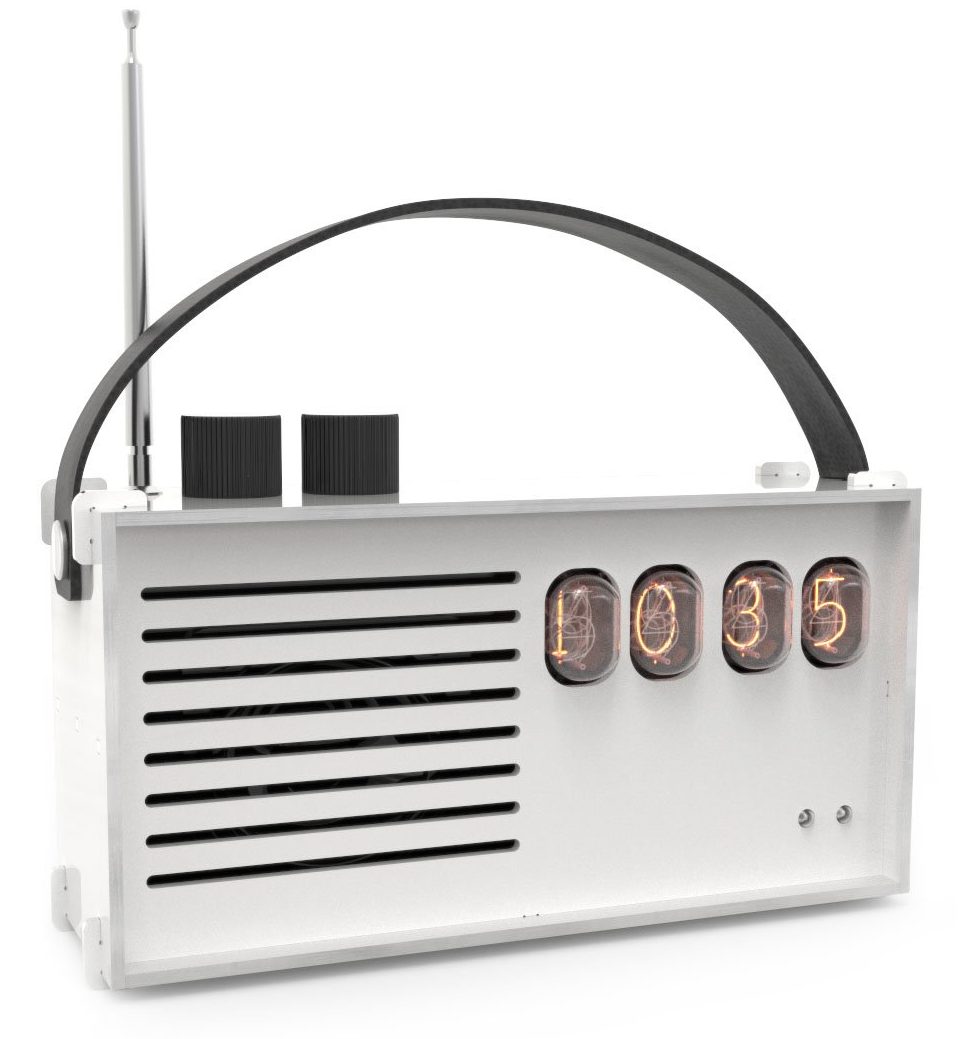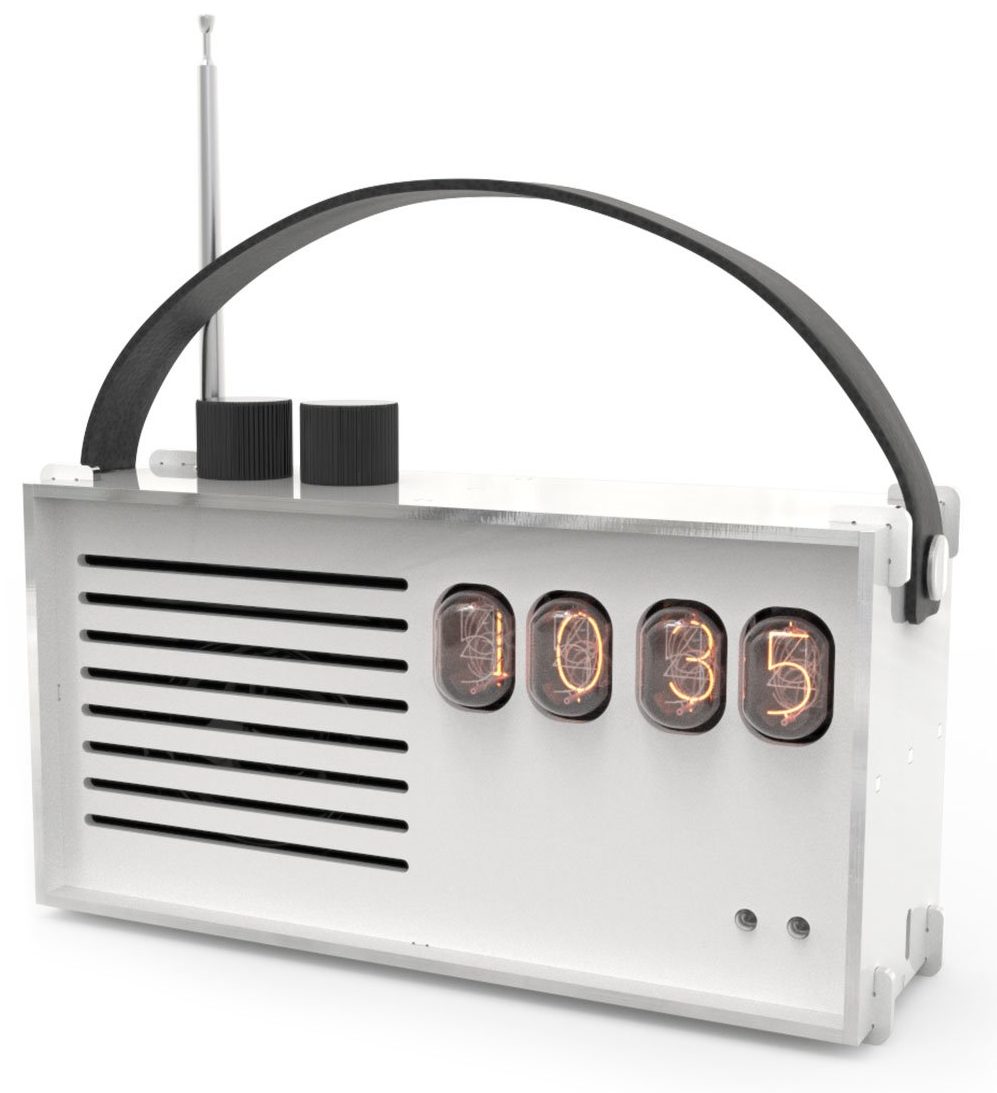Many thanks to SWLing Post contributor, Jeff McMahon, who shares a link to a Nixie Tube radio kit via the retailer Shop Simo. We’ve no clue how well the radio might perform, but it covers AM/FM, can play from an SD card and is, of course, Bluetooth as well. The radio requires no soldering–instead, it appears to be a modular snap-together kit. Here’s the manufacturer’s description:
Noyce Joyce introduces a new generation of electronic kits.
The whole kit is made of printed circuit boards (PCBs).
With a simple snap-fit connection, you get a fully functional product. In this case a battery-powered radio/Bluetooth speaker.
Our radio is [truly] unique thanks to the used miniature IN-17 nixie tubes.
These nixies stopped production 50 years ago.
For this reason, this product will be available only be in limited quantities of maximum few hundred pieces.
Right now you can buy the first 100 pieces in advance for half price.
These pieces will be delivered at the end of July.
Of course, you wouldn’t buy this radio for the performance–you’d but it for the Nixie tubes!
Thanks for the tip, Jeff!
Post readers: Please let me know if you purchase one of these! I’d love a guest post about the built and your thoughts about its functionality.




….. And people have been kept out because they aren’t white.
Spot on. Not only does Amateur Radio have a problem with attracting and retaining the younger generations but in my eyes, we’ve absolutely done jack squat at reaching out to minority communities.
It used to be I wouldn’t
I swear the last club I belonged to was filled with clones. Men of European descent in their 50s-80s with a beard, extra cushioning, and 1 syllable names.
Lol…
Cut off post.
I was going to say that I’d rarely run into younger women in the hobby. That’s changed. It’s still rare but living near an excellent engineering university, there out there.
Minorities on the other hand? Nope.
I really, really don’t need another AM/FM radio but… with nixie toobs? How cool is that? Dang! 🙂
As for the “solderless” LEGO properties. and how they destroy society, I have to agree with Mike:
Solderless, “breadboard” style electronics experimentation kits were a first step into electronics for many kids, and they remained useful for quick proof-of-concept experiments when these kids had learned what end of the soldering iron to grab. These kits became quite ubiquitous in Germany ***as early as the 1920s*** and – here’s a bold hypothesis – it looks like their popularity had no adverse effect on the supply of talent for the industry and German electronic warfare efforts being 2 steps ahead of anyone else most times (and thus needlessly protracting the war). They became even more popular after the war and gave a lot more kids (including yours truly) an instant sense of achievement and at least some basic understanding of the matter, encouraging more experimentation, an urge to learn how to solder and even careers in the industry and so on.
These experimentation boxes are still around but today’s electronics has a complexity that doesn’t allow for easy creation of stunning things with a handful of “discrete” resistors and transistors anymore, and soldering 0603 or 0402 SMD parts onto their PCBs is not a trivial task. Therefore, regular kits with an actual value when assembled often come with pre-assembled PCBs and since they’re connected with ribbon cables and connectors anyway, they are inherently “solderless”. This may not be as educational as clicking together a radio with discrete parts and winding coils for it but it could still be just as encouraging to keep on tinkering with electronics, which inevitably leads to buying a nice soldering station and watching a YouTube tutorial on how to use it.
Maybe that sentiment of “people should be able to participate” is helping to open the door more widely and in a more welcoming fashion to those who may be interested in the electronic hobby in hopes of giving someone their first experience and the elation of their first success thus inspiring them to continue forward toward more ambitious projects?
If the Radio Shack radio kits that used coil springs to make connections instead of soldering hadn’t existed when I was young then I may very well never have gotten involved in the building side of the radio/electronics hobby. That was my first step. Maybe the kit shown above can be the first step for someone else?
Nixie tubes that haven’t been made for 50 years?
Like they say on the Antique Radio Forum, “Just because
something can be done doesn’t mean it should be done”.
DO they currently make nixie tubes in Russia? seems that You can get brand new transmitting tubes from Russia. It took 50 years for the Soviet Union to switch over to capitalisim
I suppose all that Lego stuff is nice but where’s the challenge? If it falls on the floor just pick up the pieces and snap it back together. Sounds like Humpty Dumpty got an upgrade to me.
You have to crawl before you can walk, and you must learn to walk before you can run.
And fifty years ago, if you weren’t willing to try to solder, electronics wasn’t a hobby for you.
The “crawling” was that first project, hopefully a simple one, and soldering was part of it. If you felt insecure, then you started with a Heathkit, where they’d hold your hand. I recall they even sold a kit for learning how to solder, a good first step if your next Heathkit was expensive and big.
The Maker Movement wants to dumb things down, “people should be able to participate, so let’s cut out soldering, too dangerous”.
My great, great grandmother Henrietta felt racism in 1853. She didn’t need barriers lowered, she was way more capable than she perceived herself, she needed racism (and sexism) to go away.
….The Maker Movement wants to dumb things down, “people should be able to participate, so let’s cut out soldering, too dangerous”.
Could not agree more.
People become invested when exposed to situations where they’ve experienced difficulties.
Relationships, jobs, and even hobbies are longer lasting and much more enjoyed when you put the work in.
Of course, the same can be said for the current state of amateur radio here in the US. It’s never been easier to earn a ticket including Extra but somehow the decline hasn’t stopped.
People get their Tech at a church, scouts, or some other kind of cram session. They buy a Baofang, chat up a few repeaters, and then chuck it all in a closet to be forgotten about.
We’re a throw away society these days. Everything ends up in the trash whether figuratively or literally.
Fifty years ago there wasn’t the ability to purchase snap together kits….transistors were hardly available let along instructions (i.e. schematic diagrams) on how to utilize them in radio projects. My Father was trained in electronics during WW2. Post war (1950s) he had his own television and radio repair business and was an amateur radio license holder. It is from him that I learned electronics and how to read schematic diagrams and how to build radios. I consider, and realize, I was very fortunate to have had my Father get me started on a lifelong interest in electronics. There are thousands of young people who do not have that mentor to encourage them to pursue an interest in analog/digital electronics.
You can now purchase on line many prebuilt analog and digital assemblies, that were once only available if you soldered them up yourself, and it is now possible to incorporate them into complete digital projects that were unheard of twenty years ago. There are so many amazing things being done with Arduino and other basic micro controller assemblies. To belittle the maker generation is disingenuous. It is our responsibility, as those who already possess some knowledge, to freely pass it on to the up and coming. If we are of the analog generation, we should carefully measure our criticism of the digital generation.
To tie in racism to the theme of the subject of the posting, making it easier for beginners to get interested in building electronic projects, escapes me.
KZ4TN
I got my ham license when I was 12 years old. The test wasn’t a burden to overcome, it made it more appealing. I was aware that I was the only 6th grader in my school to pass the test, probably the only one who was interested.
But I was always the one picked last in gym for teams. I didn’t need to be “included”, I needed to not be part of it.
Thirty years ago Canada restructured, so the entry level test is simpler. But you also can’t build a transmitter after that test, you have to pass the advanced test. I don’t see it bringing in kids, indeed the hobby is more invisible than previously. New hams come from an older population, they don’t tests, they just want the results. And then they take leadership roles, which moves the hobby further away from where it was. QST moved the more technical stuff to QEX years back, no sense bothering people with advanced stuff, and more recently added a new magazine because “QST wasn’t for beginners”.
“Ham radio is elite, lower the barrier” and then of course you have to make it about “emergency communication” because it’s no longer a technical space.
No matter where you set entry, some will complain that entry is too hard. Aside from maybe it’s not just explaining things well, or not being out there promoting to a wider audience (I found out about ham radio in a magazine for scouting when I was nine, it was also in Jack & Jill magazine), maybe it’s really that a given hobby is not for everyone.
I have no interest in birdwatching, or sports, so maybe the people who think soldering is an obstacle should just find something else to do instead of “make it simpler” .
We have, and still do, exclude people for lots of reasons, which have nothing to do with their ability. Lack of money keeps people out, if I didn’t scrounge (and learn enough to make do with parts I could get), I’d not have been able to do much with hobby electronics or ham radio. Women have been excluded. I’ve be been stopped by cops too many times for no stated reason, I have to assume because they think I don’t belong, until it happens to you, you don’t know what it’s like. And people have been kept out because they aren’t white.
So I begin to suspect that “we have to include people” is a reaction to that exclusion, except it’s not about ability. If we have to make it simpler for Black or Native people, it’s really saying they are lesser (which is racism, and how we treated them in the past), when their entry was barred for reasons that stopped before examining their capability.
Soldering is not hard, and certainly was a requirement for decades. Do we leave people out by expecting it as a first step, or realize their interests lie somewhere else?
I’ve never driven a car in my life. I have no interest, that kicks in before a “too difficult test” or the cost of owning a car. Why is a technical skill seen as a barrier to a technical hobby?